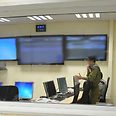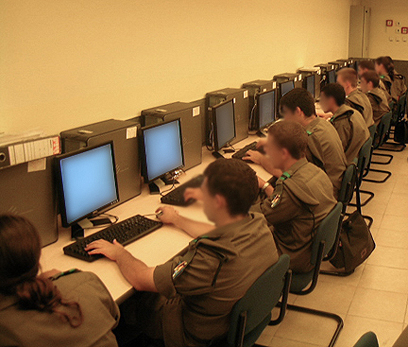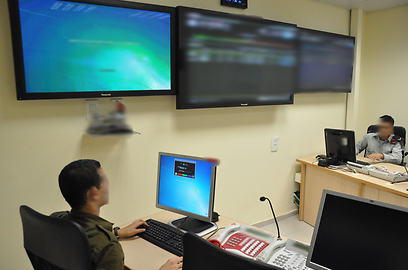
IDF says engaged in 'constant cyber battle'
In special interview, Maj.-Gen Uzi Moskovitz, head of IDF's communication branch, speaks about army's cyber warfare efforts
The IDF fends off hundreds of cyber attacks every year, Major-General Uzi Moskovitz, head of the IDF's Computer Services Directorate, revealed Sunday, in a special interview with Ynet.
According to Moskovitz, the military diligently counters cyber attacks that threaten the IDF's secure operational computer systems – systems which in turn facilitate weapons systems used by the troops on the ground, and whose failure holds soldiers lives in the balance.
Related stories
- IDF sets up war room to battle hackers
- IDF scours diaspora for cyber prodigies
- Op-ed: Welcome to cyber war
"We have improved, but the 'reds' have gotten even better," Moskovitz stressed, referring to the progress made by the division since its inception a decade ago.
"Reds" is a common code name used by the unit to dub foes and adversaries which are not officially defined as enemies by the State and are comprised of various states, organizations and corporations worldwide.
"These are states trying to work with Israel's military industries, and if they become cyber enemies there is no guarantee we will know about it.
"In the cybernetic world, I'll never know when a 'red' is an enemy. There is an unprecedented joint effort by states and corporations in this field."
The directorate's defense systems include, among others, a war room, manned around the clock by more than 20 soldiers, all specialists in the field, who are tasked with finding and destroying any attempt to infiltrate the system.
The unit also spearheads technological breakthroughs within the IDF, such as the integration of command systems and remote control systems; and is fighting their innate vulnerabilities and the constant concern that these system will themselves become targets during wartime.

Digital war room (Photo: IDF Spokesperson's Unit)
One digital ground forces system dubbed "Hunt" assists commanders in the field in locating and identifying enemy combatants, the threats surrounding them and even their fellow IDF soldiers.
"We won five wars and conquered large territories without them," Moskovitz, a Lebanon War Armored Corps veteran, said. "But the real story here is the information readily available to a commander in the field. Today, a tank commander's gets real-time intelligence about the position of a Hezbollah cell directly to his screen within seconds."
- For more on the raging cyber war click here
A byproduct of these processes is an influx of information and a desire to return to basics.
"Our programmers put hundreds of man-hours into filtering information, unlike in the Second Lebanon War, when the commanders received very little information. We want soldier to know how to fight like they used to, without computers. So in every exercise we do we take the system down for a few hours," he said.
Achilles heel
In practice, Moskovitz is charged with providing direct, immediate and secure lines of communication, deep in enemy territory, in difficult terrain, between elite forces, whole battalions and even navy forces – a situation that failed to actualize in the summer of 2006 and turned into army's Achilles heel.
"Almost every weapons system in operation today comes equipped with a built-in information and communication system. In Operation Pillar of Defense , the regiments deployed across the Gaza border were all connected, both with one another as well as with the Air Force, the Navy, the Shin Bet and Military Intelligence," Moskovitz explained.
The significance of this is a field commander's ability to receive real-time and local intelligence as he fights. This assists his in the field in a multitude of ways, including tactics optimization and minimizing casualties.

Real-time data (Photo: IDF Spokesperson's Unit)
"The strategic implication is that the ground forces can complete twice the number of missions in a given time period, all the while taking fewer risk and using less resources."
When it comes to fighting the treat posed by hundreds of thousands of missiles these advanced systems prove invaluable, significantly improving the IDF's ability to minimize the assault on the home front.
'Clearing the field'
The skills involved in the daily work of the Shoham and Lesem units within the directorate are implemented in special operations as well, where they serve to form a military-technological framework for the operations.
"Before leaving for the mission, the force needs to 'clear the field' beforehand, so as to allow secure communications with Israel for a number of days, which includes the transferring of data," Moskovitz explains.
The IDF's pioneering work in the field has garnered the United States' interest in its systems and implementation doctorates.
During a directorate visit to the US, the Americans were apparently stunned at the system's capabilities, specifically its ability to allow any relevant commander to pull up information regarding any patrol or sector on any screen – whether in his office, jeep or in the field – and pinpoint the stage of the patrol or the location of an infiltrating enemy.
The system, it seems, is able to pinpoint, in real-time, for any commander, any object in the Middle East. Without these advance systems, the IDF's output would be like it was 30 years ago.
"The IAF is the IDF's strategic weapon, and their attack capacity has increased three-to-five fold in comparison to pre-system times," Moskovitz concludes.
Ron Ben-Yishai contributed to this report
- Receive Ynetnews updates directly to your desktop










